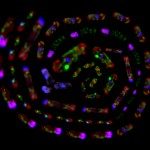Lien vers Pubmed [PMID] – 18375614
Eukaryotic Cell 2008 May;7(5):848-58
The genome of the type strain of Candida glabrata (CBS138, ATCC 2001) contains homologs of most of the genes involved in mating in Saccharomyces cerevisiae, starting with the mating pheromone and receptor genes. Only haploid cells are ever isolated, but C. glabrata strains of both mating types are commonly found, the type strain being MAT alpha and most other strains, such as BG2, being MATa. No sexual cycle has been documented for this species. In order to understand which steps of the mating pathway are defective, we have analyzed the expression of homologs of some of the key genes involved as well as the production of mating pheromones and the organism’s sensitivity to artificial pheromones. We show that cells of opposite mating types express both pheromone receptor genes and are insensitive to pheromones. Nonetheless, cells maintain specificity through regulation of the alpha1 and alpha2 genes and, more surprisingly, through differential splicing of the a1 transcript.

